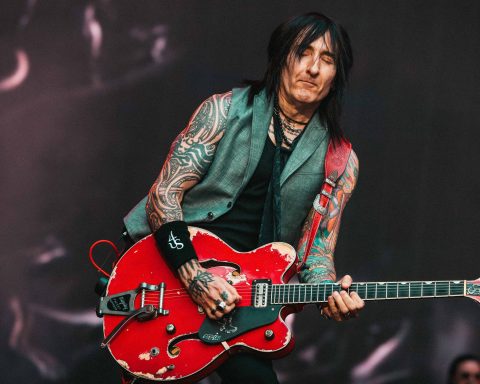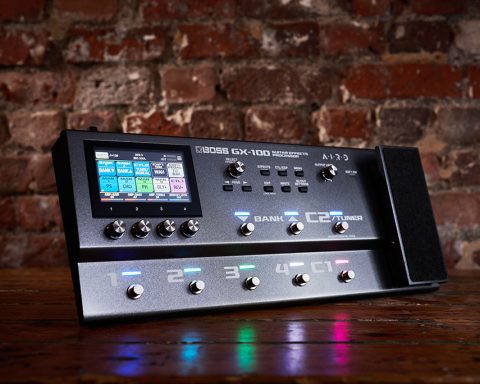When Gorillaz light up the stage, four-stringer Seye Adelekan and his GT-1000 Guitar Effects Processor power the backbone of the band’s potent bass. A multi-instrumentalist with credits spanning Self Esteem, Paloma Faith, Ellie Goulding, and many more, he channels the band’s studio wizardry into dynamic tones, deep groove, and fearless experimentation. In this inspiring interview, Adelekan shares how the GT-1000 captures Gorillaz’s constantly evolving energy, his philosophy on tone, and the secrets behind thriving as a modern session player.
Low-End Luminary
Long before joining Gorillaz, Adelekan honed his craft on London’s open mic circuit, writing songs and earning a reputation as the kind of player every band wants on speed dial. An early brush with the record industry only strengthened his resolve, pushing him to master his chops and adapt to any musical challenge.
Years of touring and session work shaped him into a musician of remarkable range and discipline. Since stepping into Gorillaz in 2017, he has become central to the band’s genre-bending live experience, blending dub, punk, and electronic textures into a low-end landscape that’s grounded yet otherworldly.
Adelekan’s partnership with the GT-1000 is crucial to his approach, giving him the tools to explore, shape, and translate Gorillaz’s studio ideas into a live sound that hits hard while remaining fluid and expressive.
Read on to discover how talent, technique, and technology thread through every groove in Adelekan’s world.
"The sets are constantly changing, which is one of the reasons I need such a versatile rig."
Seye Adelekan
From Dub to Dirt
There’s so much variety in Gorillaz’s music. How do you pull that off live?
The sets are constantly changing, which is one of the reasons I need such a versatile rig. There is a huge variety of sounds in Gorillaz’s music. Sometimes the bass needs to be really dubby, and at other times really punky, where I’ll need a dirty fuzz tone.
I’ll often need entirely different sounds in the same song. For example, there’s a track called “Fire Flies,” and the recording features three basslines. I asked Damon which one I should play, and he was like, “Um, yes?” So I had to work out auto-wah, chorus, and swell parts to play it live. It actually works really nicely. It’s become its own thing. That challenge is really fun.

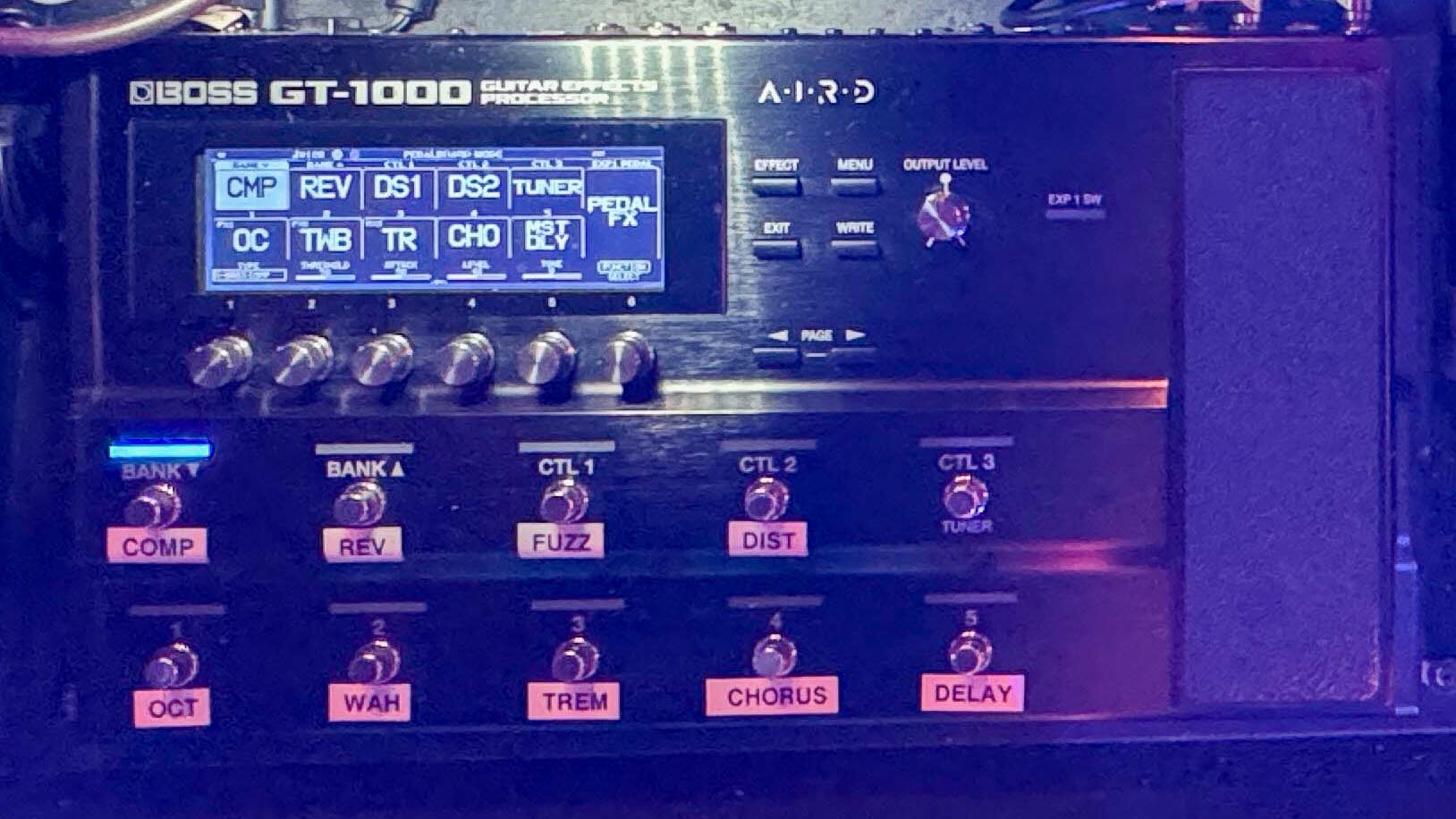
"I use my GT-1000 in Pedalboard mode, like stompboxes."
Seye Adelekan
Live Translation
How do you translate Gorillaz’s studio energy into a live show?
The secret is not trying to recapture it exactly. It’s about creating something unique from that raw material. Also, I wouldn’t want to go and see a bunch of songs played live that sound exactly the same as the record. I suppose with some pop music, the record is the record, and fans just want to hear that.
I gave up many years ago trying to do exactly what was on the record. Damon doesn’t go back; he moves forward. Every time we play something, he’ll imbue it with something new.
There are some songs we have to play at every gig, like “Clint Eastwood” and “Feel Good Inc,” and even though we’ve played them hundreds and hundreds of times, the vibe is different each time. You cannot recapture the exact same magic that happened in the studio, but you’ve got the same ingredients. It’s about making something new with those ingredients live.
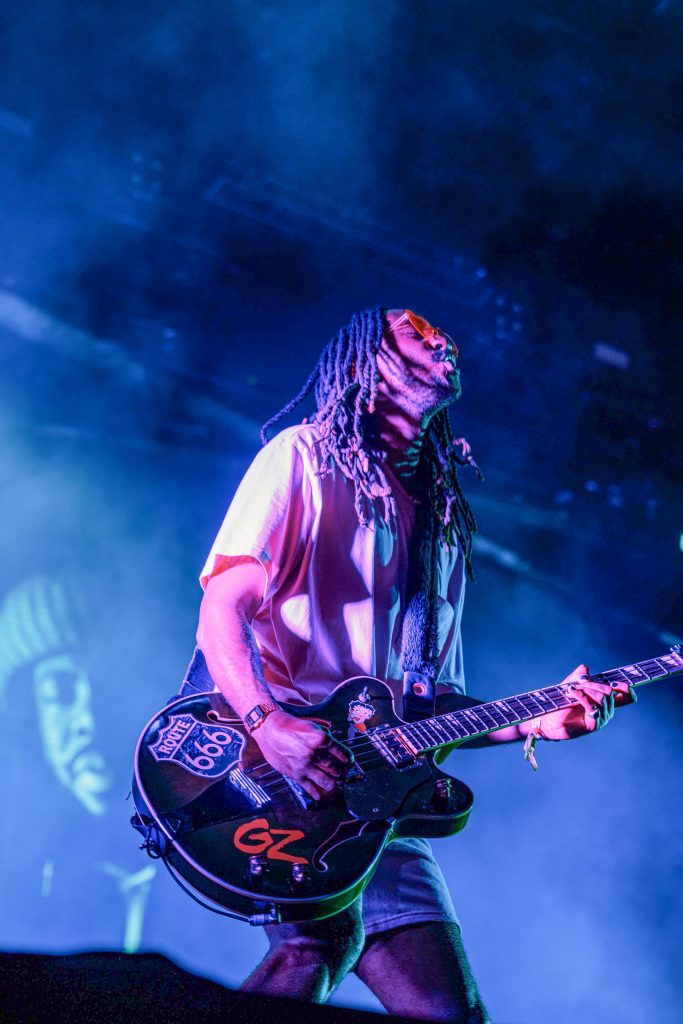
What’s your approach to building GT-1000 sounds that fit the Gorillaz world?
I’m not super technical, so I use my GT-1000 in Pedalboard mode, like stompboxes. I’ll mess around with combinations of them. I’ve got a compressor, reverb, delay, tremolo, chorus, two drives, an octaver, and an auto-wah. Sometimes, I’ll use the expression pedal for pitch shifting. I like to have those effects available and work it out from there.
I like to be a little bit spontaneous generally, but especially with Gorillaz. That palette of effects on the GT-1000 has worked perfectly for years. Before that, I used the BOSS ME-80 Guitar Multiple Effects.
"That palette of effects on the GT-1000 has worked perfectly for years."
Seye Adelekan
Our front-of-house engineer, Matt Butcher, is absolutely amazing, and he does a whole bunch of jiggery-pokery out front. I think running a MIDI rig, where you step through every section of every song, would be a bit too much. Matt will use effects live and play with his own sonic palette.
Dub Dynamics
How do you dial in that deep, dubby Gorillaz bass tone with your BOSS setup?
I get a lot of tonal variation just from my hands, and the GT-1000 compressor helps even things out. It adds a touch more sustain and helps my sound poke out a bit. That’s the one thing I have on constantly. There are so many tracks, and many of them lean into that dubby bass sound.
"I get a lot of tonal variation just from my hands, and the GT-1000 compressor helps even things out."
Seye Adelekan
Signature Sounds
What instruments are at the heart of your Gorillaz rig?
My main bass is an Eastwood Classic 4—a hollowbody strung with flatwounds—and sometimes it needs some help with sustain, so the compressor helps with that. I play a lot with my thumb, but I’ve also got gel nails, so if I really thwack the strings, I can get a pretty strong attack.
I’ll always have a four-string fitted with roundwounds of some description as well. I’ve used a Baum before. Baum is a really cool Danish builder. They’d mainly been just a guitar company up until relatively recently. My other roundwound guitar is an Eastwood Flying BV.
Do you rely on effects for your signature Gorillaz dubby bass sound?
No, I just go onto the warmest pickup and use my thumb. It’s possible to get a dubby sound even on roundwound strings that way, but I tend to use flats for that kind of sound. You can roll off the tone a bit, but I tend not to because I’m a very straightforward player. I usually have tone and volume all the way up.

I find that between my thumb, plucking with fingers, plucking with the tip of my finger, and plucking with my nails, I can get a lot of different sounds. Even a downstroke has a different sound from an upstroke when using your thumb. Some of the bass tones from old dub records sound like the speaker is being overloaded, and you can kind of get close to that with a touch of overdrive.
"My GT-1000 has been deeply road-tested, and it’s still going strong."
Seye Adelekan
Rock-Solid Rig
Has the GT-1000 stood up to life on the road with Gorillaz?
It’s never let me down. It’s always remained consistent, whatever country we’re in or whatever the weather is like. I’ve just never had a problem. I’ve got a spare unit, but in all the years I’ve used a GT-1000, I’ve never had to go to the B rig. Never. It’s rock solid. They’re built extremely well.
With some effects units, you wonder if you can actually step on them in the throes of a sweaty gig. You want something you know can just handle life on the road, and the GT-1000 is it. My GT-1000 has been deeply road-tested, and it’s still going strong.
The other cool thing is that no matter where you are in the world, if the worst comes to the worst, you could always pick up another unit because BOSS gear is so easily available everywhere. It would be super easy for my tech to just bring up the same familiar settings or transfer them from one unit to another.
I was chatting to Johnny Marr, who uses the GT-1000, and he was saying he doesn’t even travel overseas with them anymore. He’ll just get hold of another one wherever he’s playing and download his settings. That’s pretty smart.
"I want to be able to bring something great to the stage that’s unique. Not only that, but something consistent."
Seye Adelekan
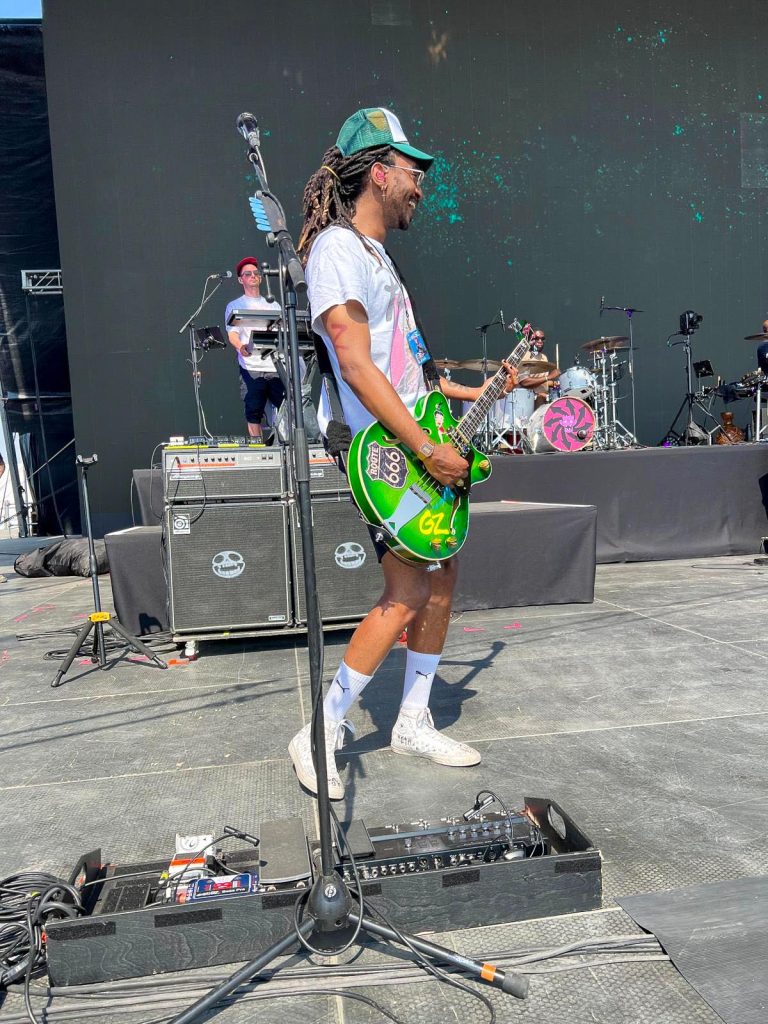
Do you approach effects differently on the road than in the studio?
In the studio, you can have all your favorite vintage effects and whatever it is that you like to use. You can go really niche and geeky in the studio. But there are certain pedals you might not want to take on the road. I find having loads of pedals on stage and having to tap dance is annoying.
With the GT-1000, you can get sounds that are just as good, if not comparable or different. Having a certain sound in the studio and a slightly different sound live isn’t a bad thing. Some people think you’re doing the record a disservice if you’re not using the same exact rig. But I disagree.
I want to be able to bring something great to the stage that’s unique. Not only that, but something consistent. A lot of people stick rigidly to their studio gear, to their detriment. A Gorillaz tour lasts several months, and I want something I can rely on anywhere in the world at all times.
"A Gorillaz tour lasts several months, and I want something I can rely on anywhere in the world at all times."
Seye Adelekan
Own Your Tone
Do most fans notice the difference between multi-effects and pedals?
Most people aren’t guitar geeks. Through a PA system at a festival or gig venue, the difference people can hear between a multi-effects processor like the GT-1000 and a load of pedals is tiny.
Plus, no one cares. People are there to hear good music. They won’t suddenly have a bad time because they realize you’re using multi-effects and modeling. It’s a question of: did it sound good or not? Matt, our front of house guy, is like, “Make it sound good and I’ll make it sound better.”

How do you approach the debate between digital and analog gear?
Because of so many significant technological advancements, most people can finally relinquish the shackles of tribalism regarding digital versus analog. It doesn’t have to be one or the other. Like, can we just make cool sounds, please? They’re tools.
I’m the same with instruments. There’s been a democratization of gear. You can get great sounds for virtually any budget—a lot of the gatekeeping around that has disappeared. I’m not saying digital is better than analog or vice versa. Who cares where the sound comes from as long as it’s good? At the end of the day, my BOSS GT-1000 does everything I could possibly want.
"My BOSS GT-1000 does everything I could possibly want."
Seye Adelekan
Homework in Harmony
Do you have any tips for being successful in session work?
Be kind, be on time, learn the songs, and ask questions. Sometimes, people are afraid to ask questions because they think it might make them look bad. My advice is to ask the MD ahead of time if you need help with something, as opposed to turning up to rehearsal unprepared, bearing excuses.
I don’t get sent music because I learn by ear beforehand, which is the case with many musicians. It’s a different story if you’re doing a pit job in the West End, but I hate looking at notes while playing. I think it’s the worst. It becomes a crutch for some people. I don’t have any notes in front of me by the time I get to rehearsals. When you’re looking at a sheet, you’re not looking at other people.
Practice is for you. Rehearsal is for everyone.
Follow Seye Adelekan: @seyemusic




